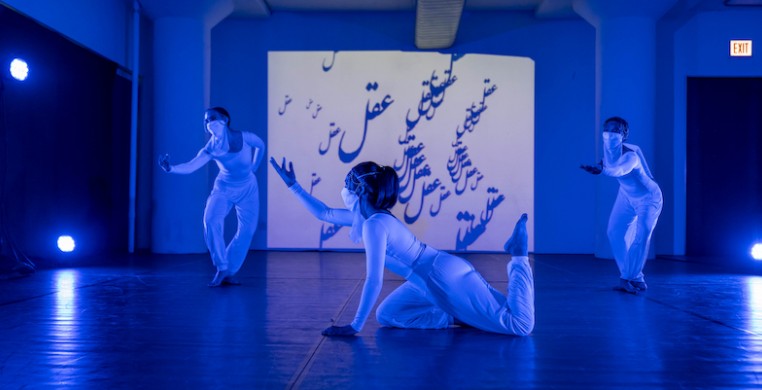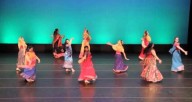For the first time since the start of the pandemic, I attended a live dance performance. I felt like a fish out of water as I was reacquainted to routine audience etiquette: cell phones off, choosing the correct seat and picking up a handheld brochure. Saturday at Mana Contemporary, approximately 15 special guests crossed their legs and leaned in to experience Mandala South Asian Performing Arts' latest concert, “With Rumi.” As I checked to be sure my face mask was secure, three shadows emerged.
The intriguing first piece, “Nizami’s Seven Princesses”—choreographed by Mandala artistic director Pranita Nayer and further devised by Moeka Osada and Ashwaty Chennat—is an ambitious interpretation of the poem “Haft Paykar” by Persian Poet Nizami Ganjavi. Dancers Chennat, Keeley Morris and Nicole Volpe invited us into a world of mystery and seduction luring us with enigmatic eyes. Lighting designer Geoffrey Bushor saturated each scene with intense color, diversifying the space with color-changes like a mood ring, each look unique enough to create a portrait for the seven princesses of Ganjavi’s poem. Dressed in white umbrella-like pants, gold head dresses and face masks, the trio weaved in and out of seven warm and cool colors, maintaining ambitious postures, adapting the persona of seven princesses with half as many women.
I must admit I was unfamiliar with the 12th Century Persian masterpiece on which this piece is inspired, but after a little research I was again intrigued to find out more about the complexities involved in this work. In “Haft Paykar,” red, blue, green, yellow, white, black and brown are the colors that represent domes housing seven brides. Each day of the week is dedicated to a particular bride and the tales she shares with the main character, Sassanian ruler Bahram V Gur. Although each portrait possessed an energy of its own, I gravitated first to the neon green scene which projected animated calligraphy created by a talented high schooler, animation artist Aadit Arora. Employing classical bharatanatyam in the hands and upper body, the dancers’ postures were fresh and sprouted like new foliage. I was further moved by the enticing red scene. My mind veered to the power of the serpent in both the physical and spiritual realms. Blood also became a thought as it is a vital connector and force that keeps our stories alive inside of us. Mesmerized by a live taar soundtrack played by musician Farzad Amoozegar, I achieved a transcendental state that left very little separation between myself and the many elements at play working to achieve the oneness that governs South Asian culture.
The second piece, “Shadow and Light,” was guided by the mature and dynamic sound of another high schooler: cellist Manou Magdalena Chakravorty. Accompanied by an equally impressive pianist, Elizabeth Vaughan, the dynamic duo provided a compelling soundscape for soloist Ashwaty Chennat to curve into. Drawing from the work of renowned Persian poet Rumi, calligraphy appeared and disappeared on the scrim, peeking from behind a curling Chennat and her shadow. I found my body swaying back and forth longing for an alphabet of my own—hoping this Persian calligraphy (created by Leena Gharpure) could somehow reinvigorate a memory. I thought of an old Persian dish my roommate would make when I lived in Barcelona— tahdig was the name.
As I floated in and out of my memory, I thought about memory as an entry point into a new culture—identifying common characteristics that revived dormant experiences. Calligraphy did just that for Nayar. One of her original inspirations for creating this work was a memory of calligraphy on tombstones in a graveyard in her hometown in India.
An afternoon paying homage to Persian poetry concluded with “Here and Now,” a surprising performance art piece performed by the graceful Laksha Dantran. Inspired by Persian philosopher, poet and mathematician Omar Khayyan, “Here and Now” is an intimate look into the careful process of calligraphy as Dantran delicately dipped the tale of her long braid into trays of crimson colored paint. Using two large white tarps, Dantran transported us to a pre-digital era when we took our time, where she further explores Ishq (an Arabic word for love and passion) through her live painting performance of calligraphy on the tarps.
Dantran reminds us of Khayyans’ very words: ”Be happy, enjoy life, what’s here, is not here, it will all pass.”


